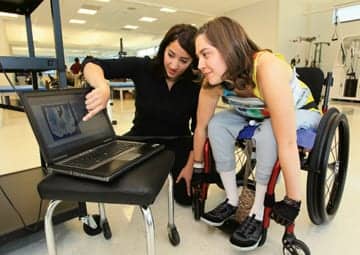The use of interface pressure mapping as part of the wheelchair seating evaluation.
by Jill Garcia, MS, OTR, ATP, and Sarah Lusto, PT, MSPT, ATC

The wheelchair seating evaluation is a complex process that must be inclusive of several distinct components, variables, and participants, and covers a full spectrum of interventions. It involves the collaboration of several parties including the client, clinician, and physician, and must take into consideration the specific needs of the wheelchair user in combination with the benefits and limitations of the wheelchair technology. The wheelchair seating evaluation also requires the clinician to be informed about current best practice guidelines, evidence-based literature, and technological advances to accurately assess the needs and goals of their clients and ensure that the evaluation process reflects the individual client’s physical and functional needs.2 When used as a component of this overall assessment, interface pressure mapping (IPM) can be a valuable tool in providing objective data to assist in determining the optimal seating surface for a wheelchair user.3
Why Use Interface Pressure Mapping?
There are many factors and considerations that influence clinical decision-making during the selection of a wheelchair seating system, and these are addressed through a comprehensive seating and mobility evaluation. IPM, when used in conjunction with a full anatomical and postural seating evaluation, can be a useful tool to assist in selecting an optimal seating surface. IPM can assist the clinician in ruling out inappropriate seating surfaces and identifying a seating system that affords the patient optimal postural symmetry, while also providing optimal pressure redistribution.
While seating and positioning needs vary based on interaction of multiple intrinsic and extrinsic factors, there is a broad need for comprehensive evaluation—including IPM—across all paradigms of wheelchair users. For the new wheelchair user, IPM can assist in the prevention of potential secondary complications of spinal cord injury (SCI). Among current wheelchair users, IPM may be used to address seating and mobility deficits or development of pressure ulcers by examining the current seating surface and setup.
Utilizing Interface Pressure Mapping
There are a number of interface pressure mapping systems on the market. In general, these systems consist of a sensor array contained within a flexible mat that is used to measure interface pressure between the client and the support surface.4 The data from the sensory array are displayed onto a computer screen in real time, and provide a numerical reading at each sensor location that can be used to generate an objective picture of the selected cushion’s ability to redistribute pressure.
The IPM system can be utilized to evaluate the entire seating system including back supports and cushions. There are numerous manufacturers that produce back supports and cushions, each designed to accommodate the specific needs of a wheelchair user. Back supports can vary in width, height, and contour with this variability, allowing for optimal postural alignment and stability or accommodation for significant postural deficits. Wheelchair cushions are broken down into several categories including general use, positioning, skin protection, and skin protection and positioning. These cushions are variable in composition and may be comprised of foam, visco-elastic foam, gel, viscous fluid, and air either used alone or in combination with more than one medium.
Selection of a seating system for assessment and trialing is largely based on the initial mat evaluation of the client in both the supine and seated positions, with the pelvis in a neutral position and the patient’s head, neck, trunk, and extremities supported as appropriate. Obtaining a postural assessment and anatomical measurements with consideration for the client’s specific functional needs allows the clinician to home in on the category of cushion or back support available to meet specific postural and pressure-relieving needs. The ultimate goal is to ensure the seating system that is selected will allow for optimal functional performance while addressing the specific postural and pressure-relieving needs of the wheelchair user. It is also important to note that other factors play a role in cushion selection, including a client’s presentation and tolerance, wheelchair design, mobility goals, and functional needs.
Once the cushion or back support is selected for trialing, and the patient’s optimal positioning needs have been determined, the client is seated on the cushion with the pressure mapping mat correctly aligned over the cushion to minimize the occurrence of hammocking. An initial reading is achieved, and the visual data from the sensor array can be used to determine optimal positioning of the sensor array and pelvis, as well as the overall symmetry. The clinicians can then palpate and adjust positioning of the client to ascertain the most neutral pelvic alignment during data collection.
Consistency is an essential during an IPM study, and each seating surface must be assessed with the same method. It is customary to trial a minimum of three cushions to achieve an adequate assessment and allow for comparison of various materials.
In addition to static trials, IPM can be utilized in dynamic functional scenarios with the use of a remote component that allows assessment of the cushion when the client is propelling and engaging in functional activities. Some IPM systems also have additional mats and components that can assess temperature and shear forces that may play a role in superficial sitting-acquired pressure ulceration.3,5
What Do All Those Numbers Mean?
When interpreting the results of pressure mapping data collection, several variables must be assessed to gather the qualitative information needed to help facilitate the selection of an optimal seating surface. These variables are peak pressure index, co-efficient of variation, symmetry, sensing area, pressure gradient, and dispersion index. The peak pressure index is used to determine the average pressure over a given area, and can help identify and compare at-risk areas typically found under bony prominences such as the ischial tuberosities and greater trochanters, since increased peak pressures indicate poor emersion.6 The co-efficient of variation indicates the uniformity of distribution from one sensor to the next with a lower co-efficient of variation demonstrating increased consistency of pressure redistribution.5 Assessment of symmetry determines right/left pressure redistribution of the lower extremities and pelvis, and can be useful in determining the impact of the seating system on postural support and alignment, as there can be significant discrepancies in symmetry with individuals who present with pelvic obliquities or rotations. The sensing area—or contact area—notes the quantity of distribution throughout the seating surface with a higher sensing area indicative of improved distribution of pressure over an increased surface area.5,6 Measurement of pressure gradients can be used in combination with other variables, such as peak pressure index, to help determine the degree of envelopment of bony prominences by indicating how close the high pressures are to the low pressures by measuring the change in pressure per centimeter or inch, with the objective to have the lowest possible gradient.6 Finally, the dispersion index (DI) identifies the percentage of total pressure compared to sacro-coccygeal areas. Evidence supports that a DI greater than 50% indicates high pressure ulcer risk.7
There is little evidence to support specific conclusions drawn from a single variable, and no identification yet of critical parameters that reduce the risk of secondary complications such as pressure ulcer development. However, there is evidence to suggest that the use of both the numerical and visual data collected from IPM studies can be helpful in generating relative comparisons between various seating surfaces to help eliminate those surfaces that are inappropriate and identify those that offer the greatest degree of postural support and pressure redistribution. 5,6,8,9
Putting It All Together
The information presented in this article is meant to provide a general view of the purpose, use, and potential impact of IPM as part of the seating and mobility evaluation. There is no artifice that IPM alone can provide some magic number or definitive picture capable of determining a wheelchair user’s optimal seating surface. Quantitative data cannot replace clinical judgment and physical assessment. Rather it is, like all the other methods we have, a tool that offers the opportunity to combine quantitative findings with clinical reasoning and qualitative data to create a dynamic picture of a wheelchair user’s seating and positioning needs. While wheelchair seating is a specialty that spans multiple professions, there is a collective commitment to evidence-based practice and evidence-based learning that drives our professional ideals. IPM is a way for clinicians to address this commitment, expand best practice guidelines, influence the direction of future research, combat funding sources, and help create standardized guidelines that in turn will improve patient outcomes and quality of life. RM
Jill Garcia, MS, OTR/L, ATP, is an occupational therapist clinical specialist at Kessler Institute for Rehabilitation, West Ornage NJ. She specializes in spinal cord injury and mobility, and is an adjunct professor at Seton Hall University.
Sarah Lusto, PT, MSPT, ATC, received her BS in sports medicine and MS in physical therapy from Quinnipiac University. She currently works as a physical therapist on the spinal cord unit at the Kessler Institute for Rehabilitation in West Orange, NJ. For more information, contact [email protected].
References
1. LaPlante M, Kaye HS. Demographics and trends in wheeled mobility equipment use and accessibility in the community. Assist Technol. 2010;22:3-17.
2. Shea M, Arledge S, Armstrong W, et al. RESNA Wheelchair Service Provision Guide. Approved by RESNA Board of Directors January 26, 2011. To be submitted to the Assistive Technology Journal.
3. Connolly SJ, McIntyre A, Titus L, et al. Wheeled mobility and seating equipment for the spinal cord injured individual. In: Eng JJ, Teasell RW, Miller WC, et al, eds. Spinal Cord Injury Rehabilitation Evidence. 2012. Version 4.0.
4. Jan Y, Brienza DM. Technology for pressure ulcer prevention. Top Spinal Cord Inj Rehabil. 2006;11(3):30-41.
5. http://www.pressuremapping.com/File/PPTs/Best1.ppt#256,1,PRACTICAL PRESSURE MAPPING PowerPoint presentation by Andrew Frank, Vista Medical.
6. Davis K, Sprigle S. The science of interface pressure mapping—updates for clinical application. Georgia Institute of Technology. 2010. www.mobilityrerc.gatech.edu/publications/ScienceInterfacePressure.pdf. Accessed December 2, 2012.
7. Drummond D, Breed AL, Narechania R. Relationship of spine deformity and pelvic deformity on sitting pressure distributions and decubitus ulceration. J Pediatr Orthop. 1985;5(4):396-402.
8. Norton L, Swaine J. Managing pressure: three choices now! In: Proceedings of the 22nd International Seating Symposium. Vancouver, BC; 2006:218-221.
9. Shelton F, Barnett R, Meyer E. Full-body interface pressure testing as a method for performance evaluation of clinical support surfaces. Appl Ergon. 1998;29(6):491-497.




